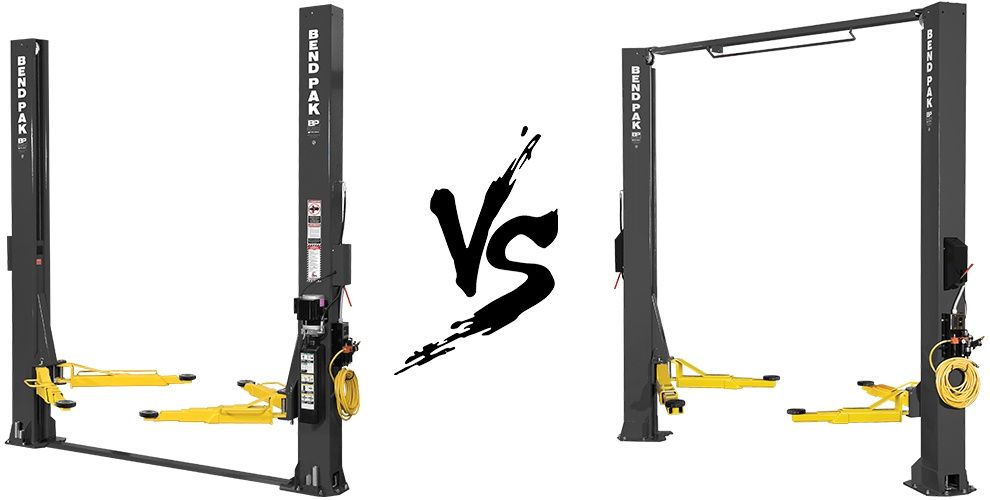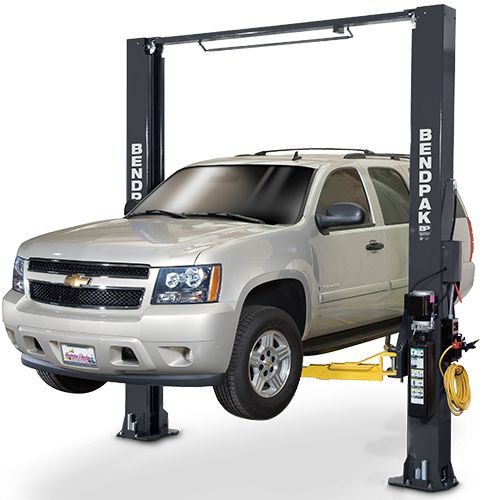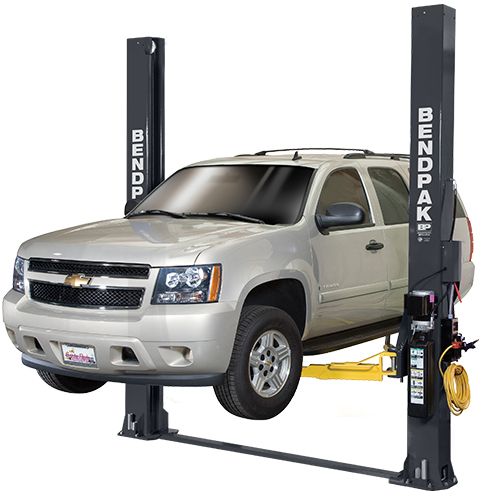Overhead vs. Floorplate two-post lift Models

Using a lift? It’s a ground game. Working on cars and trucks requires more physical fitness than most realize. Your days are packed with troubleshooting, repairing vehicles while standing, working on hot engines, and trying to find that lost metal spacer that evaporated off of your tool tray. And often it helps to raise that “ground game” up from the floor on a BendPak 2-post auto lift for ample under-car access.
To raise vehicles on a sturdy BendPak two-post auto lift, items such as hydraulic lines, cables and mechanisms are uniquely routed to convey power to both column lifting arms. Operating in concert, they work as a “Team Effort”. The originating hydraulic pressure is usually produced from a mounted pump on one column (power-side). Accordingly, a lifting system requires a “transferring assembly” mounted between both columns that provides a pathway for those hydraulic lines and cables to fully power this corresponding movement.
Transferring assemblies used to distribute this power are either in the form of an “overhead assembly” (between the tops of both columns) or as a drive-over “floorplate two-post lift” (between the bottoms of both columns). But which is the better location to incorporate these systems within a 2-post auto lift? Although an overhead and floorplate two-post lift both accomplish the same general lifting task often utilizing similar mechanisms, the two types present different ergonomic characteristics to perform their duties. Choosing the 2-post auto lift that works best for you is paramount.
Here’s a quick list of general design differences
Overhead Assembly (Closed Top Models):
- Hydraulic lines and equalizer cables run through an OVERHEAD ASSEMBLY mounted across the top of the 2 columns
- Overhead Assembly Leaves Open Floor Between Columns-Unobstructed
- Optional column extensions (depending on model) can increase overhead clearance (conditional to ceiling heights) to accommodate taller vehicles
Floorplate two-post lifts:
- Hydraulic lines and cable systems run under a metal FLOORPLATE mounted between both columns
- Floorplate two-post lift’s Open-Top Design (no overhead assembly over the top) eliminates above obstruction, which accommodates higher vehicles
- Angled low-profile “floorplate drive-over approaches” allows vehicles and floor jacks to travel across; both forward and rearward.
Discover the Lift Style that Fits Your Workdays Better
Since many physical factors come in to play such as vertical ceiling height limitations, column heights, overhead assembly height limitations, floorplates, and more, choosing the appropriate type is dependent on which will net better workshop efficiency. Why is this important? Because the 2-post auto lift that best matches its physical features and attributes to your shop’s dimensions and vehicles repaired, delivers the most useful service.
To provide added info, we will lay out further details about an Overhead vs. Floorplate Two-Post Lift. In other words, the strategic information to help you select which style benefits the types and sizes of vehicles you repair better.

Overhead Assembly-Two-Post Lifts
Does your shop’s work activity require unobstructed concrete between the posts? Models that feature an “Overhead Assembly” (aka Closed Top) utilize a power transfer system that resides up high at the tops of both lift posts. Think of it as up-and-over and nothing runs across the floor. From there, hydraulic pressure from the pump on the power-side post along with corresponding cable movement, sends the power up and over to the opposite post to activate the lift arms. The overhead assembly is basically a large protective housing panel, and not a structural device.
This style is also referred to as a “Closed-top” or “Clearfloor”. This is because the “Overhead Assembly” design leaves a bare Clearfloor. This allows the fore-and-aft free rolling movement across the floor of toolboxes, floor jacks, oil drains, and other shop equipment under a vehicle that is raised up in the air. With a sufficient amount of vertical room to accommodate the 2-post lift, an overhead assembly can handle a variety of vehicles with lots of weight and height that works under the closed top. Specs for each lift’s overall column heights are listed on each BendPak lift model’s respective page. And this style can be installed in either a wide or narrow configuration because the top is adjustable.
Besides determining column height clearance, keep in mind the total height of vehicles you generally service. This is because although the columns may fit the “under-ceiling dimensions” the size of the overhead assembly will consume its own space; often as much as 10” to 12”. The net dimension per lift model can more accurately be determined by obtaining the floor-to-overhead switch dimension against the overall column height dimension. Remember too, to allow at least 1” of clearance between any lift to any ceiling. Then compare related dimensions to vehicle heights that you work with. Especially the mentioned dimension from the bottom of the overhead assembly switch to the floor below. This measurement is how much total vertical distance (measured in inches) you will have for a vehicle with an overhead assembly in place.
If you require higher lifting range than the standard lift provides, some BendPak 2-post lift models with Overhead Assemblies have optional column extensions available. In the event of lifting a vehicle that that comes in contact with the overhead assembly, a padded safety bar when activated by contact from a raising vehicle will halt the upward moving lift arms. Note, this is a safety feature and contact with the switch should best be avoided. For more height options, check the respective model on BendPak’s website.

Floorplate Two-Post Lifts
Looking for lots of upward mobility and your shop commonly works on much taller vehicles? A Floorplate two-post lift allows you to typically raise vehicles higher than an overhead assembly lift might allow. These are also known as Open Top designs. This is because there is no overhead assembly ultimately in the upward pathway. Instead a Floorplate two-post lift routes hydraulic lines across the floor, between the columns, and under a rugged panel. In other words, the floorplate assembly is mounted on the concrete and you can drive larger vehicles across it. A Floorplate two-post lift can be a helpful solution when you are often working under taller vehicles and have no Clearfloor concern between the posts.
If this style is what might serve your needs best, BendPak has several floorplate two-post lifts that are designed to raise heavy work vehicles. The floorplate mounted across the ground is tough enough to keep hydraulic lines and mechanisms lines safely guarded. The Floorplate is generally about 2” tall and 8.5” across (check www.bendpak.com for exact spec) so it is not much of an impediment for big tires. Floorplates are designed with approaching and backing away angled ramps so that vehicles can transition fore-and-aft without much notice. With a floorplate two-post lift, you can raise a van with roof racks loaded as long as you have the ceilings to accommodate it.
See all the two-post car lifts we offer






